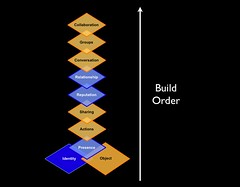There has been a lot of discussion of late in the social media circles about cooperation and how all social tools and services and their managers need to embrace that model. What is really clear is they have never run or tried to run social environments at any scale that have a broad representation of a population.
In reality there are at least three interactive community types that show up in representative populations, like those you get in a town or a city, or an organization’s internal social platforms. The three interactive community types are: 1) Cooperation; 2) Coordination, and 3) Competition. These three all work in tension with each other. In smaller social settings you will likely run into cooperation and it can work swimmingly. But, the reason that it works so well is there are likely not differences of opinion, different, motivations, and counter purposed goals.
As any social setting grows in size the cohesion and common interests (homogeneity) are diluted with other inters and motivations, just as a hamlet grows into a village, they ease of cooperation moves into the dire need for coordination. As we move to towns or cities, or larger organizations with more than a few hundred people or across more than one location coordination is needed. Cooperation is often quite easy with small groups, but even getting more than two or three small groups to work easily coordination is needed as the ease, and often the pure ability, of cooperation is gone and there needs to be concerted effort and guidance applied through coordination. There can be coordination through agreement as much as their can be coordination through difference. The skills needed for those polar realities are different, but the ability to listen, negotiate, mitigate, and coerce is needed.
The underlying tension is related to competition, which run very strong in certain personality types, but also in various industries. The social interaction designs for competitive personalities are very different from cooperative or those who are comfortable in coordinated models. But, nearly all populations have some representation (small or large) of people (or organizations) who are highly competitive. Thinking that in a social environment, unless it is small and focussed, our community or social interactions are going to be purely cooperative is a bit naive and crazy (or a great way to go crazy quickly).
It really takes understanding humans social interactions at scale and working in them for a few years to see the realities. Humans are as diverse as they are similar and there is no generalizing how humans behave with out understanding the variety of social types (personality, social interactions, social roles, organizational types, and work role types among others). Talk with any organization of any size (above a few hundred people or even one hundred people with more than one location) and you see the difficulties of finding one solution and one way forward.
![Reblog this post [with Zemanta]](http://img.zemanta.com/reblog_e.png?x-id=db7a8b23-e75c-4cf7-bc51-4a3302e7cf8b)
